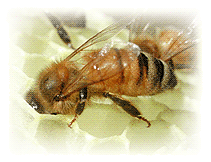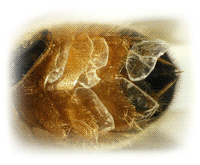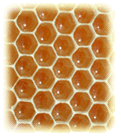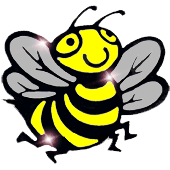
How do Bees Make Honey?
Honey bees obtain two things from flowers: nectar (for honey production) and pollen. As the female worker bee sucks nectar from flowers, it is stored in her special honey stomach which she uses as a "nectar backpack". This is completely separate from her digestive stomach although there is a valve connecting the two which she can open when hungry. This allows her to pass through some honey to be converted to energy for her own needs. After visiting between 150 to 1500 flowers, the honey stomach is full and almost equal in weight to bee herself. At this point the worker bee laboriously returns to the hive with her load.
The worker bees retuning to the hive laden with nectar are often confused with other workers returning with pollen (they never do both on the same trip). Worker bees have hair-like "baskets" on their hind legs and it is into these that they pack pollen grains while visiting flowers. These bees are easily identified because of the brightly colored orange (and sometimes yellow) pollen packed into their baskets. They present an almost comical appearance as they "waddle" about the hive carrying their oversized loads of pollen. The pollen is sometimes referred to as "bee-bread", and when mixed with honey forms the diet of the next cycle of brood being raised in the hive. When inspecting the brood combs of a hive, a multicolored ring of pollen can normally be observed encircling the brood in the center of the comb.
 A bee returning to the hive with a load of nectar is almost immediately greeted by other workers ready to relieve her of the load. A mouth to mouth transfer is normally done between a field bee and one of the hive bees as the adjacent photo shows. Notice the extended "tongues". The recipient bee processes the honey in its mouth and honey stomach by the addition of enzymes that break the complex sugars in the nectar into simple sugars that is both more digestible by the bees and ultimately gives the honey its characteristic long "shelf life".
A bee returning to the hive with a load of nectar is almost immediately greeted by other workers ready to relieve her of the load. A mouth to mouth transfer is normally done between a field bee and one of the hive bees as the adjacent photo shows. Notice the extended "tongues". The recipient bee processes the honey in its mouth and honey stomach by the addition of enzymes that break the complex sugars in the nectar into simple sugars that is both more digestible by the bees and ultimately gives the honey its characteristic long "shelf life".
 Nectar returned to the hive at this point is barely recognizable as honey. The nectar initially is nearly 80% water with the remainder consisting primarily of complex sugars. After processing the honey with enzymes, small droplets are typically deposited on the upper side of a cell wall awaiting its final conversion into viscous honey with which we humans are acquainted. This conversion is largely an evaporation process which, in turn, is hastened by the warm temperature (95 degrees F) maintained in the hive and the movement of air across the honey combs. Leaving nothing to chance, the bees actually control the movement of air by fanning their wings in a coordinated effort. The buzzing sound coming from a hive (even at night when there is no flying) is due to this "forced evaporation" process. The end result is thick, viscous honey with a 17% - 18% moisture content.
Nectar returned to the hive at this point is barely recognizable as honey. The nectar initially is nearly 80% water with the remainder consisting primarily of complex sugars. After processing the honey with enzymes, small droplets are typically deposited on the upper side of a cell wall awaiting its final conversion into viscous honey with which we humans are acquainted. This conversion is largely an evaporation process which, in turn, is hastened by the warm temperature (95 degrees F) maintained in the hive and the movement of air across the honey combs. Leaving nothing to chance, the bees actually control the movement of air by fanning their wings in a coordinated effort. The buzzing sound coming from a hive (even at night when there is no flying) is due to this "forced evaporation" process. The end result is thick, viscous honey with a 17% - 18% moisture content.
In the peak summer months a worker bee literally works herself to death visiting flowers and transporting the precious cargo back to the hive. During this frenzied time of activity in preparation for the coming winter, a worker bee only lives approximately 35 days. At the end of her days, her wings become so frayed that her usefulness is over and she is rejected by the colony.
Honey History
It is believed that honey history dated as far back as 10 to 20 million years ago and the practice of beekeeping to produce honey, apiculture, dates back to at least 700 BC.
In ancient times, Eygptians sacrificed honey by the tons to their river gods, Roman legions slathered honey on the wounds as a natural cure to promote healing, and medieval lords reserved honey for their private use. It's told that the body of Alexander the Great was preserved and embalmed with honey. As honey was then expensive and not all could afford it, its use in cooking was reserved only for the wealthy. And ancient myths and writings on alcoholic beverages throughout the world also contain references to mead, or honey wine, which is known as the world's oldest fermented berverage.
The biblical history also contains honey facts biblical history also contains honey facts related to its benefits and goodness. Honey, a delicacy fit for the kings and queens!
When refined sugar made from sugar cane came along, it provided a relatively inexpensive alternative form of sweetening and began to displace honey for culinary use. The benefits of honey since then became more focused on its medicinal properties and its use in fine gourmet and confectionary.
Today, the word 'honey” has gone beyond its association with its benefits as a food and has crept deep into many cultures and languages. Click here to read on "Words with Honey and Bees",
Honey Expiration Date & Storage
Honey is a miracle food; it never goes bad. It was reported that archaeologists found 2000 year old jars of honey in Egyptian tombs and they still tasted delicious! Many people find it rather surprising that bacteria cannot grow in honey because all things being equal, bacteria loves sugar. The unique chemical composition of low water content and relatively high acidic level in honey creates a low pH (3.2-4.5) environment that makes it very unfavourable for bacteria or other micro-organism to grow. Thus, "Best Before Dates" on honey buckets indicating honey shelf life do not seem to be very important after all.
Amazing Facts...About Honey and Your Health
1. Honey contains vitamins and antioxidants, but is fat free, cholesterol free and sodium free!
2. One antioxidant called "pinocembrin" is only found in honey.
3. Honey is the only food that includes all the substances necessary to sustain life, including water.
4. Honey has the ability to attract and absorb moisture, which makes it remarkably soothing for minor burns and helps to prevent scarring.
5. Honey speeds the healing of open wounds and also combats infection.
6. As recently as the First World War, honey was being mixed with cod liver oil to dress wounds on the battlefield.
7. Modern science now acknowledges honey as an anti-microbial agent, which means it deters the growth of certain types of bacteria, yeast and molds.
8. Honey and beeswax form the basics of many skin creams, lip-balms, and hand lotions.
9. According to Dr. Paul Gold, a Professor of Psychology at the University of Virginia, "people remember things much better after they've consumed glucose, a form of sugar found in honey."
10. Honey is nature's energy booster! It provides a concentrated energy source that helps prevent fatigue and can boost athletic performance.
11. Recent studies have proven that athletes who took some honey before and after competing recovered more quickly than those who did not.
12. Honey supplies 2 stages of energy. The glucose in honey is absorbed by the body quickly and gives an immediate energy boost. The fructose is absorbed more slowly providing sustained energy.
How Bees Make Wax
It all begins on a flower in a field. Bees collect nectar from flowers and bring it to the hive where it becomes either beeswax or honey. A bee's diet consists primarily of honey, and any honey not consumed by the bees or in the raising of brood is stored as surplus and is ultimately consumed in the winter months when no flowers are available. However, it is honey's other use that interests us, its conversion into beeswax.
The production of beeswax is essential to the bee colony. It is used to construct the combs in which the bees raise their brood and into which they store pollen and surplus honey for the winter.
 Worker bees, which live only around 35 days in the summer, develop special wax-producing glands on their abdomens (inner sides of the sternites of abdominal segments 4 to 7) and are most efficient at wax production during the 10th through the 16th days of their lives. From about day 18 until the end of its life, a bee's wax glands steadily decline. Bees consume honey (6-8 pound of honey are need to produce a pound of wax) causing the special wax-producing glands to covert the sugar into wax which is extruded through small pores. The wax appears as small flakes on the bees' abdomen. At this point the flakes are essentially transparent and only become white after being chewed. It is in the mastication process that salivary secretions are added to the wax to help soften it. This also accounts for its change in color.
Worker bees, which live only around 35 days in the summer, develop special wax-producing glands on their abdomens (inner sides of the sternites of abdominal segments 4 to 7) and are most efficient at wax production during the 10th through the 16th days of their lives. From about day 18 until the end of its life, a bee's wax glands steadily decline. Bees consume honey (6-8 pound of honey are need to produce a pound of wax) causing the special wax-producing glands to covert the sugar into wax which is extruded through small pores. The wax appears as small flakes on the bees' abdomen. At this point the flakes are essentially transparent and only become white after being chewed. It is in the mastication process that salivary secretions are added to the wax to help soften it. This also accounts for its change in color.
The exact process of how a bee transfers the wax scales from its abdomen to its mandibles was a mystery for years. It's now understood to be processed in either of two ways. Most of the activities in the hive are cooperative so it should be no surprise that other worker bees are willing to remove the wax scales from their neighbors and then chew them. The other method is for the same bee extruding the wax to process her own wax scales. This is done using one hind leg to move a wax scale to the first pair of legs (forelegs). A foreleg then makes the final transfer to the mandibles where it is masticated, and then applied to the comb being constructed or repaired.
 Beeswax becomes soft and very pliable if the temperature is too high (it actually melts at 149 F). Likewise, it becomes brittle and difficult to manage if the temperature is too low. However, honeybees maintain their hive at a temperature of around 95 degrees Fahrenheit, which is perfect for the manipulation of beeswax, not too hot to be drippy and not too cold to be brittle.
Beeswax becomes soft and very pliable if the temperature is too high (it actually melts at 149 F). Likewise, it becomes brittle and difficult to manage if the temperature is too low. However, honeybees maintain their hive at a temperature of around 95 degrees Fahrenheit, which is perfect for the manipulation of beeswax, not too hot to be drippy and not too cold to be brittle.
A honeycomb constructed from beeswax is nothing short of a triumph of engineering. It consists of hexagon shaped cylinders (six-sided) that fit naturally side-by-side. It has been proven by mathematicians that making the cells into hexagons is the most efficient shape. The smallest possible amount of wax is used to contain the highest volume of honey. It has also been shown to be one of the strongest possible shapes while using the least amount of material.
The color of beeswax comprising a comb is at first white and then darkens with age and use. This is especially true if it is used to raise brood. Pigmentation in the wax can result in colors ranging from white, through shades of yellow, orange, and red all the way to brown. The color has no significance as to the quality of the wax (other than its aesthetic appeal). Formerly, wax was bleached using ionization, sulphuric acid, or hydrogen peroxide which resulted in the inclusion of toxic compounds. Bleaching has now been abandoned by reputable candle manufacturers and other suppliers of beeswax.
If beeswax has a medicinal smell, chances are that it has been chemically altered or bleached.
Beeswax Facts
Throughout the ages beeswax played a significant role in history and folk lore. From the myth of Icarus flying too close to the sun with wings made of beeswax to Pilyn (23 AD to 79 AD) who described a broth made from beeswax used as a remedy for dysentery and as a skin softener, beeswax was frequently used by the ancients. In some cultures beeswax was used as currency and was highly prized. In fact, in 181 BC when the Romans defeated the Corsicans, they imposed at tax of 100,000 pounds of beeswax.
In the 1300's farmers in France paid an annual tax of 2 pounds of beeswax each. One can only wonder what became of the unfortunate farmers with no beekeeping skills. In that same century a petition was presented to the London Court of Alderman by the 'Worshipful Company of Wax Chandlers" which ultimately established them as the oldest English guild. During the same period the Roman Catholic Church decreed beeswax candles to be the only candle appropriate for use in Catholic churches.
Even in modern times beeswax finds many uses and applications. As one goes back in time the list becomes even longer. In fact, the importance of honey production in ancient times was secondary to the production of beeswax. The following are but a few of the applications of this incredibly versatile substance:
Candles and ornaments
Lip balm
Cosmetics and medicinal creams
Foundation for new honeycomb in hives
Slippage prevention for belts in vacuum cleaners, sewing machines, etc.
Waterproofs shoes, fishing lines
Lubricant for doors, windows, tools
Wax for skis, toboggans, bow strings
Creates a freely moving surface on irons and frying pans
Furniture polish
Soap making
Beard and mustache wax
Grafting wax
Crayons
Sealing on jams and jellies
Reconstructive surgery
Leather waterproofing
"Lost-wax" method of casting
Embalming procedures
Dental procedures
Polishes
Wood filler
Tack cloth
Glass etching
What's so great about beeswax as a candle and as a fuel in general? First and foremost, beeswax candles burn brighter, longer, and cleaner than any other candle! The flame emits essentially the same light spectrum as the sun and in the process of burning emits, negative ions that are known to clean the air and invigorate the body (reportedly, stimulating the puitary gland, thus increasing creativity, intuition, and dream activity).
Finally, this 100% natural fuel created by bees is naturally scented by the honey and nectar of flowers packed into the honeycombs and gives off a subtle fragrance as it burns. In short, it's a natural substance straight from mother nature.
Beeswax vs Paraffin
Beeswax is a 100% natural fuel created by bees. <> Paraffin is a toxic byproduct of the oil industry.
Beeswax candles burn cleaner than any other. <> Paraffin candles give off many of the same toxic fumes as are found in auto exhaust.
Beeswax candles burn longer than others and do not drip. <> Paraffin candles are relatively short burning and drip excessively.
Beeswax candles emit bright light that has the same light spectrum as the sun. <> Paraffin candles produce a disorganized light spectrum very similar to old-fashioned incandescent bulbs.
Beeswax candles emit negative ions that actually clean the air and invigorate the body. <> Paraffin candles produce toxic petrol-soot that eventually stains all interior surfaces.
Beeswax candles are naturally scented by the honey and nectar of flowers packed into the honeycomb within the beehive. <> Paraffin candles typically contain artificial fragrances and colors which also produce toxins and stains when burned.
Beeswax candles come from a renewable resource: beeswax <> Paraffin candles come from a nonrenewable resource: petroleum.
